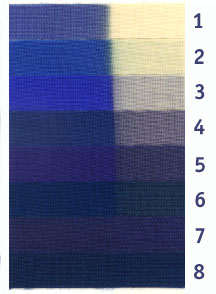CPSA conducts its own ongoing lightfastness testing using a sunlight exposure test in accordance with ASTM standard D5383. This testing was initially done by Rhonda Farfan, vice president of consumer standards emeritus, and has been carried on by each successive product research director. Our lightfastness testing represents a continued commitment to provide colored pencil artists with the knowledge and support necessary to make artwork that will last a lifetime.
For each colored pencil to be tested, a small sample is made by heavily and evenly applying color to a test board. Half of each sample is covered to block out sunlight and the other half is left exposed. The samples are placed in an outdoor box with a clear glass lid, made in accordance to ASTM specifications. The box faces south with the samples angled 45 degrees to maximize sun exposure on the uncovered portion of the test boards. Each board also includes a blue wool card with 8 different strips of dye with varying degrees of lightfastness. This card acts as the control and when it fades to a certain degree, we know the samples have been exposed long enough.
The next step is to place each pencil into one of the lightfastness categories (I top rating, II, III, IV, or V). Five volunteers rate each sample on a scale of 1 to 8, and an average of those ratings is taken to determine the lightfastness category.
NOTE: As a benefit of membership, CPSA members may download the Lightfastness Workbook by logging into the members-only portal.
Blue wool samples with lightfastness rating (7+ being the best rating, 0 being the worst).

Color samples as rated by 5 independent observers based on the blue wool sample above.

